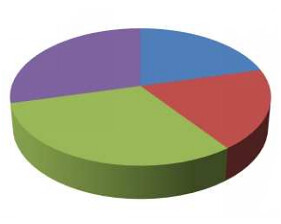This is the third in a planned series of
blog posts on topics that are discussed in depth in the SEI Sustainability
Committee’s forthcoming technical report, Building Structure and Global
Climate, due out later this year.
In this
example, a cradle-to-gate LCA was conducted to determine the embodied impacts
of concrete on a building to compare the Global Warming Potential (GWP) of a
reference building using typical concrete mixes with moderate amounts of Supplementary
Cementitious Materials (SCMs) such as fly ash and slag and a proposed building
using concrete mixes that have relatively high volumes of fly ash and slag. The
building is an 18 story residential tower located in the northeast United
States. Compressive strengths for each structural element are identified in
Figure 1.
Figure 1. Specified
compressive strength of concrete for an 18 story residential tower.
The first
step in the analysis is to identify typical concrete mixes for the reference
building. In 2014 (updated in 2016), National Ready Mixed Concrete Association
(NRMCA) published benchmark mix designs and their environmental impacts for
eight different regions in the United States (www.nrmca.org/sustainability). This
example uses the benchmark mix designs for the Northeast region.
The next
step is to estimate mix designs that have significantly lower GWP than the
benchmark mixes that still meet the performance criteria (strength, durability,
etc.). This example uses high volume SCM mixes from the NRMCA Industry-Wide
Environmental Product Declaration (EPD). A summary of the concretes selected
for the reference and proposed building are provided in Tables 1 and 2.
Table 1. Mix designs
selected for the reference building (from NRMCA benchmark report)
Concrete
Element
|
Specified
Compressive Strength (psi)
|
Portland
Cement (lbs/yd3)
|
Slag
(lbs/yd3)
|
Fly Ash
(lbs/yd3)
|
SCM
content
|
Mat
Foundation
|
6000
|
782
|
119
|
82
|
20%
|
Basement
Walls
|
5000
|
741
|
112
|
78
|
20%
|
Floors
B2-1
|
5000
|
741
|
112
|
78
|
20%
|
Floors
2-18
|
5000
|
741
|
112
|
78
|
20%
|
Shear
Walls
|
6000
|
782
|
119
|
82
|
20%
|
Columns
|
8000
|
967
|
147
|
102
|
20%
|
Table 2. Mix designs
selected for the proposed building
Concrete
Element
|
Specified
Compressive Strength (psi)
|
Portland
Cement (lbs/yd3)
|
Slag
(lbs/yd3)
|
Fly Ash
(lbs/yd3)
|
SCM
Content
|
Mat
Foundation
|
6000 psi
|
256
|
342
|
256
|
70%
|
Basement
Walls
|
5000 psi
|
242
|
323
|
242
|
70%
|
Floors
B2-1
|
5000 psi
|
512
|
0
|
341
|
40%
|
Floors
2-18
|
5000 psi
|
581
|
0
|
249
|
30%
|
Shear
Walls
|
6000 psi
|
427
|
256
|
171
|
50%
|
Columns
|
8000 psi
|
503
|
302
|
201
|
50%
|
Using the
Athena Impact Estimator for Buildings (Athena IE) software (www.athenasmi.org), the reference building
and proposed building were defined using the proposed mixes in Table 1 and 2
respectively. Athena IE has the NRMCA benchmark mixes and the NRMCA
Industry-Wide EPD mixes pre-loaded into the software. The software also permits
the user to define new mixes based on the existing mixes in the library or
completely new mixes if that information is available from a concrete producer.
Once all the
concrete information is defined for each project, the user can then run a
report that will provide the estimated GWP, along with other impacts, for each
building. The reference building will represent the largest impacts and the
proposed designs will represent lower impacts. The results for this example
showed that the reference building has a GWP for concrete of 6.14 million kg CO2
while the proposed building has a GWP for concrete of 3.92 million kg CO2
meaning that the high volumes of fly ash and slag mixes resulted in 36%
reduction in GWP as shown in Figure 2.
Figure 2. Summary of
GWP for reference building and proposed building.
Keep in
mind, this is example was simplified for illustration purposes. It only
considered the effects of concrete during the material extraction and
manufacturing stage on the environmental impacts of the building. The Athena IE
software does contain environmental impact information for most materials and
products used in buildings and allows input of operational energy data for
conducting a more comprehensive whole building LCA.
















